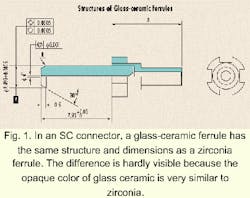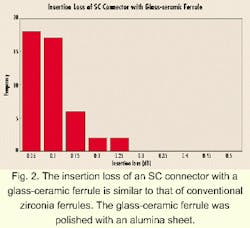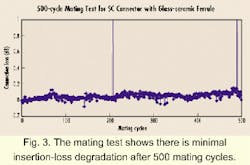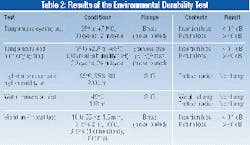A new glass-ceramic ferrule technology for optical connectors
By Tania Concejo, Senko Advanced Components Inc., and Hirokazu Takeuchi, Nippon Electric Glass Co. Ltd.
A recently developed ferrule technology offers comparable performance to other ferrule materials at much lower manufacturing costs.
Fiber-to-the-business and -home, is the optimum technology to support growing data-transport demand. Prohibitive cost, however, is still a deciding factor against this practical setup. In light of this dilemma, several innovations in fiber and optical-component technology have resulted from developers' desire to promote fiber-optic communications by enabling cost-reduction measures without sacrificing performance. A new glass-ceramic ferrule technology developed for high-performance, low-cost optical connectors accomplishes both these objectives.
The most expensive part of an optical connector is the ferrule. Until now, only zirconia ferrules achieved the required performance and quality level--at a high cost for the component and its required polishing process.
The test series described here shows that the glass-ceramic ferrule's performance offers the same level of insertion/return loss, durability, and reliability as the zirconia ferrule. Further, this new ferrule type is proven to be suitable for both singlemode and multimode applications.
The structure of the glass-ceramic ferrule, which consists of a precision glass-ceramic sleeve and a flange, is the same as the zirconia ferrule (see Fig. 1). The outer diameter measures 2.499 ± 0.0005 mm and the inner diameter measures 0.125 to 0.126 mm. The glass-ceramic ferrule is made of amorphous glass material in a stable matrix. Unlike the commonly known borosilicate glass ferrule, which is clear, the glass-ceramic ferrule is opaque and very similar to zirconia.During the manufacturing process, the conventional zirconia ferrules require precise and lengthy polishing to obtain accurate inner and outer diameters. The glass-ceramic ferrule only needs to be cut to a proper length, machined at both ends--outer chamfering at the top and inner chamfering at the bottom--and attached to the flange. It requires no polishing.
During the test series, the material properties of the different ferrule types were analyzed using the bending strength test. Test results in Table 1 show the bending strength of glass-ceramic, alumina, and zirconia ferrules. The bending strength test was conducted on a 2.499-mm glass-ceramic ferrule at three different points at a load speed of 100 mega-pascal (MPa)/sec. As shown in Table 1, the bending strength of a glass-ceramic ferrule with singlemode specifications is similar to that of an alumina ferrule. Glass-ceramic material has a higher bending strength than ordinary glass material because the crystal boundary stops the crack growth and prevents it from breaking.Test results also indicate that the glass-ceramic ferrule's expansion coefficient of 2.7 parts-per-million (ppm)/C is much lower than for other materials used for ferrules (see Table 1). This physical stability is an advantage, indicating highly reliable contact between optical connectors that use glass-ceramic ferrules. Moreover, the stress caused by differences in the thermal expansion of the ferrule and the fiber is minimized because both use glass material.
The glass-ceramic ferrule's hardness measurement is also lower than its alumina and zirconia counterparts (see Table 1). The lower Vicker's hardness measurement indicates that the glass-ceramic ferrule is softer than other ferrule materials, which enables easier polishing and facilitates optical-connector assembly.
Under these conditions, polishing costs can be reduced dramatically, especially when compared to conventional zirconia ferrules. Overall polishing time is shortened even if the glass-ceramic ferrule only requires alumina or chromium polishing film; it does not require diamond polishing film. Cost reduction is further achieved by the glass-ceramic manufacturing process, which uses the thermal softening properties of glass. Consequently, this new type of glass-ceramic ferrule allows a low-cost fabrication process compared to that of zirconia.
In the second part of the test series, the performance of optical connectors assembled with glass-ceramic ferrules was analyzed. The glass-ceramic ferrules for singlemode fiber were used in SC connectors.
Figure 2 shows an insertion-loss histogram of an SC connector with a glass-ceramic ferrule that was polished only by an alumina sheet. Insertion loss and return loss were measured at random connections using 9.5/125-micron singlemode fiber at 1310-nm wavelengths. Each ferrule was oriented to its best position in relation to the housing at four 90° rotations.The glass-ceramic ferrule endfaces were polished using an inexpensive physical contact (PC) polishing film. The alumina polishing consists of three steps: epoxy removal, polishing, and finishing. The time required for the whole alumina polishing process is 400 sec, which is shorter than the 400 sec needed for zirconia polishing with diamond. Test results demonstrated that glass-ceramic ferrules polished with low-cost alumina film have an average insertion loss of 0.06 dB and an average return loss of 50 dB. These performance measurements are similar to those of zirconia ferrules polished with expensive diamond film.
A 500-cycle mating test was conducted to measure insertion-loss degradation. For this performance test, two SC connectors with a glass-ceramic ferrule and an SC adapter with a zirconia splitsleeve were used. The insertion loss was measured after every mating. The results show that the glass-ceramic ferrule is a highly durable material. During and after the 500-mating cycles, minimal insertion loss degradation was detected (see Fig. 3).The test results demonstrate that a glass-ceramic ferrule is equivalent to a zirconia ferrule in terms of performance. When assembled in an SC connector, the glass-ceramic ferrule offers an average insertion loss (0.06 dB), an average return loss (50 dB), and reliability that is comparable to the performance of a conventional zirconia ferrule. Moreover, with the glass-ceramic ferrule, significant cost reductions are achieved due to the minimum polishing required. Thus, the glass-ceramic ferrule is suitable for singlemode and multimode applications where zirconia ferrules are currently in use.
The development of this low-cost optical-component technology is significant because it may accelerate the adoption of fiber in future technologies and applications. It has the potential to be widely used in fiber-to-the-home and in business networks.
Tania Concejo is a marketing coordinator at Senko Advanced Components Inc. (Southboro, MA). She can be reached at [email protected]. Hirokazu Takeuchi is the manager of the electronic product division at Nippon Electric Glass Co. Ltd. in Japan.




